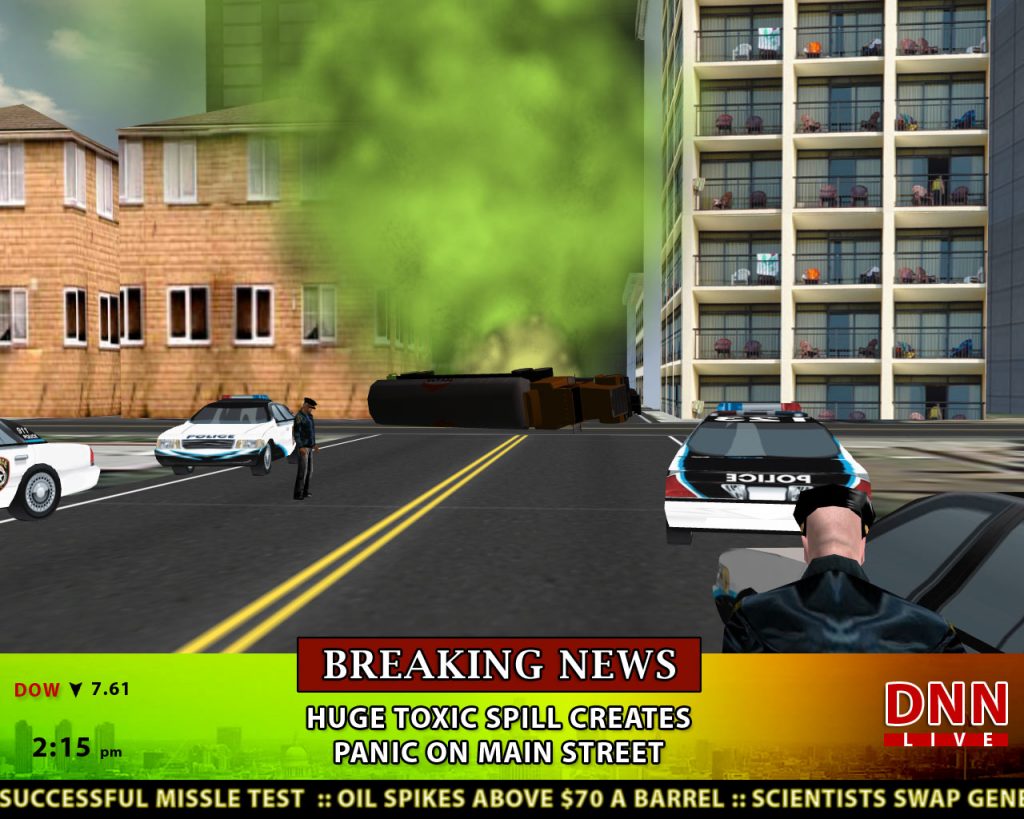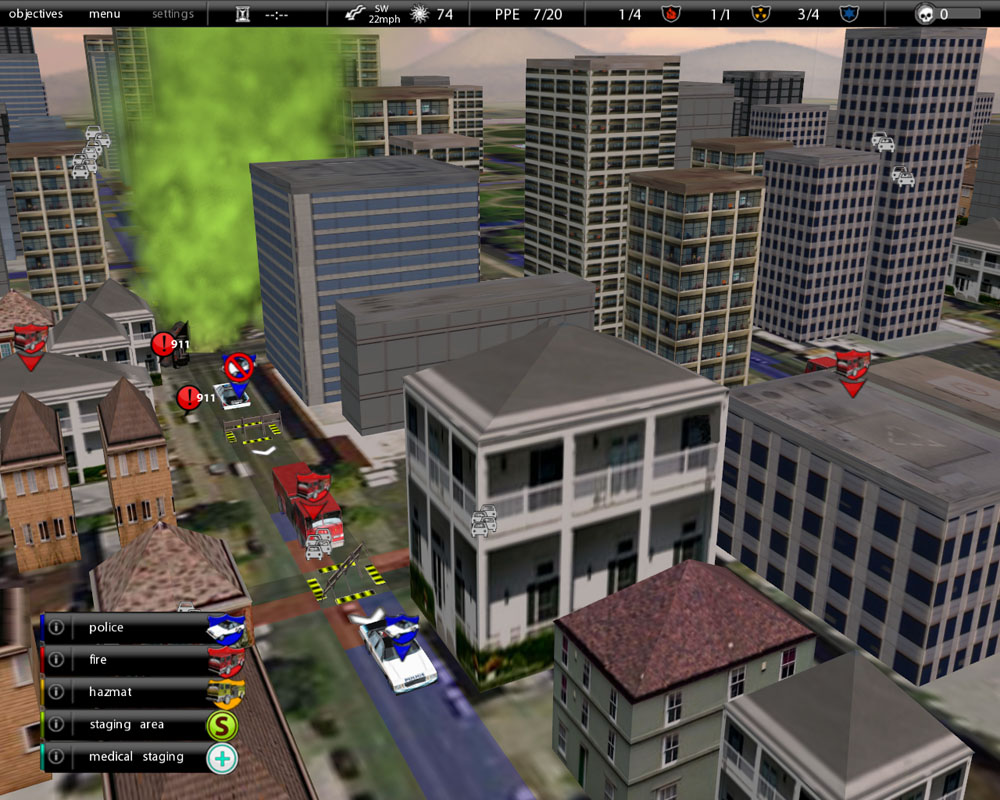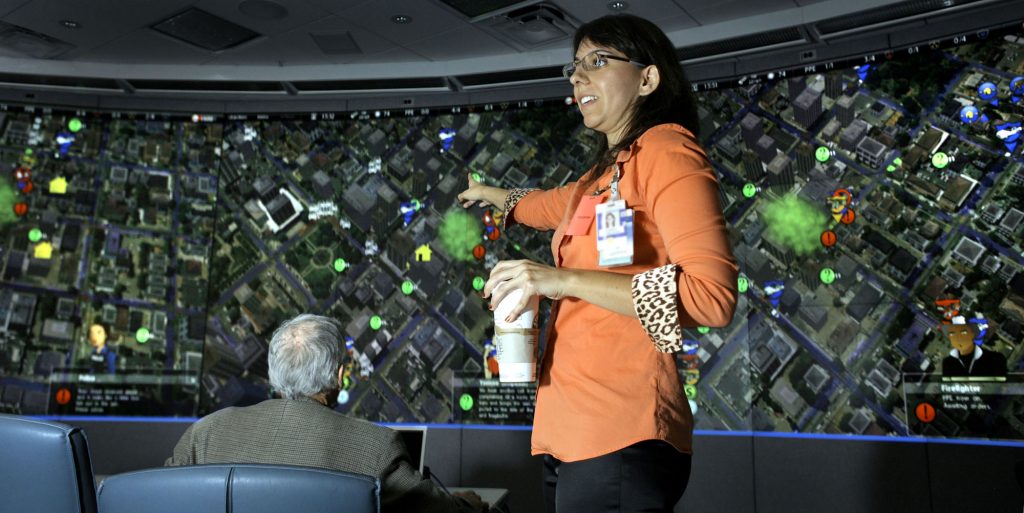Emergency response personnel impressed in prototype demo-trial

LIVERMORE, CALIF. — Peanut butter and jelly. Wine and cheese. Dinner and a movie. Some things just naturally go together.
But national security and video games? At first glance, those two aren’t exactly a soft brie and a glass of Merlot in terms of compatibility. If Sandia computer scientist and software engineer Donna Djordjevich has her way, however, perhaps today’s video game-loving youth will become our next generation’s terrorist-fighting scientist, especially if a prototype project she now has under development with the University of Southern California’s GamePipe Laboratory fulfills its promise. And a recent demonstration of the prototype for real-world emergency responders indicates she is on track.
Djordjevich is the principal investigator of a Sandia-funded project titled “Game Technology-Enhanced Simulation for Homeland Security.” Its mission is to create an interactive gaming platform specifically designed to prepare decision makers and first responders for weapons of mass destruction/weapons of mass effect (WMD/WME) attacks in metropolitan areas. The first version of this platform, more commonly known as “Ground Truth,” provides a virtual environment where users can play through such a scenario to see the effects of their decisions under the constraints of time and resources. The project was funded and started in FY07, with development beginning last October.
Sandia is a National Nuclear Security Administration laboratory.

Tapping into video gaming culture
Modeling, simulation, and, yes, gaming, have been around Sandia for years. But Djordjevich, a USC alumna and self-described “obsessive-compulsive gamer,” is a true believer who suggests Sandia could do even more to take advantage of our current video game culture, perhaps even integrating gaming in a formal way into the lab’s homeland security program activities and elsewhere.
“Video games are progressive, intuitive, accessible, and immersive,” says Djordjevich, making them an ideal framework for training and learning. Firemen, police officers, and other first responders, she asserts, are used to being “on the scene” of an incident, so gaming mechanisms that thrust users into a “real” environment are a great fit for training and education purposes.
Djordjevich started playing her first video game – Super Mario Brothers on the original Nintendo – at age six, on a system purchased by her parents but intended for her brother. She says the “interactive simulation-based” interface offered by video games is more effective than the “press play, then walk away” style of video training or the pre-scripted scenarios moderated by expert facilitators that often take a day or longer to run through a single threat scenario.
Ground Truth is part of the “real-time strategy” genre of video games and an example of the “serious games” movement. A 2006 article in the New York Times titled “Saving the World, One Video Game at a Time” asserts that this “new generation” of video games “can be more than just mindless fun, they can be a medium for change… (The movement) is a partnership between advocates and nonprofit groups that are searching for new ways to reach young people, and tech-savvy academics keen to explore video games’ educational potential.”
The GamePipe Laboratory, part of the USC Viterbi School of Engineering’s computer science department, has emerged as a major training ground, with nearly 100 students now pursuing BS and MS degrees in games specialization, including a large number focusing on game training tools, also known as “serious games.” Five of these students are now working on Ground Truth, according to GamePipe director Mike Zyda, interacting with Djordjevich and a group of Sandia staffers. The project is in its first year of a three-year Sandia commitment.
Visuals call to mind “SimCity”
Visually, Ground Truth looks somewhat like the popular “SimCity” city-building simulation game, with a nameless urban environment at the center of the action.
The current scenario involves a chlorine spill, and users are required to move pieces around – much like a chess game – in order to best mitigate the consequences of the incident. They can choose from various functional “pieces,” including Firefighters, Police Officers, Hazmat teams, or they can activate Staging and Medical Staging areas.
If an accident scene requires a roadblock to divert traffic, for example, a user might choose to send the police to the area. Medical Staging might be engaged to treat victims, though users need to keep an eye on any toxic fogs that could impact the success of the operation. A “progress thermometer” in the upper right-hand corner of the computer screen helps them to gauge the success of their moves. The game takes roughly 20 minutes to play.

Designed for incident commanders
In its current form, says Djordjevich, Ground Truth is designed for high-level incident commanders who need to understand how to best allocate their resources (hence the “big-picture” aerial view on the screen) given the unusual circumstances defined by WMD/WME threat scenarios. The game also educates its users on the dangers faced by on-scene emergency responders. Those playing the game, for instance, quickly learn that only certain responders are able to wear personal protective gear, so “you don’t want to be sending your police officers into an area where they might face a cloud of toxic gas.” Future scenarios, Djordjevich hopes, will aim to engage personnel who actually respond to scenes, treat victims, as well as involving decision-makers at higher levels and jurisdictions.
Djordjevich also plans to incorporate feedback from authentic emergency response personnel into Ground Truth. A recent visit to Sandia/California by members of the Alameda County Public Health Department featured a Ground Truth demonstration and was well received. “I thoroughly enjoyed playing Ground Truth, even though video games are not in my culture. The game made one comfortable in making decisions … you have done a great job,” said James Pointer, MD, the department’s medical director.
Though she’s focusing on the work at hand, Djordjevich can’t help but imagine bigger and better things with Ground Truth and the video gaming arena at Sandia. While Ground Truth may one day become a licensable product that comes on DVD, she envisions DHS Secretary Michael Chertoff being won over by a demonstration and demanding that the program be endorsed, paid for, and delivered by DHS to first responders all over the country. “Then maybe we’ll be ready to launch Sandia’s Center for Interactive Gaming Applications,” she says with a laugh.
USC news media contact: Eric Mankin, mankin@usc.edu, (213) 821-1887, http://gamepipe.usc.edu

